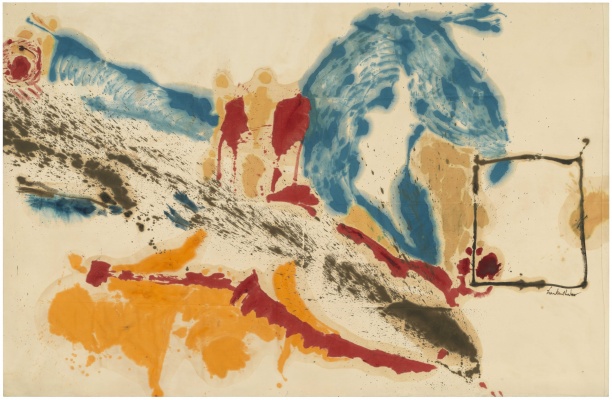Descripción de la Exposición
carlier | gebauer, Berlin presents the exhibition 'Radiate and Fade Away', with works by Lúcia Koch, Anna Bella Geiger and Tarik Kiswanson.
Following Lúcia Koch’s 2023 solo exhibition Light Falls, we are pleased to present a dialogue between Koch, Anna Bella Geiger, and Tarik Kiswanson. Each artist explores the concept of in-between spaces—physical, political, and psychological—that shape our experiences. Together, they question the fixed nature of identity, space, and perception, urging a reevaluation of displacement and fluidity.
In works like Dupla, Koch uses color and transparency to disrupt the functionality of windows, transforming them into objects that no longer serve their typical role of offering a view. Their original purpose—being a passage or opening—is lost, as there is no longer a literal aperture in the wall. Instead, the window frustrates the viewer’s expectation, reflecting them back rather than offering a view into the beyond. The acrylic panes, which shift in color and opacity as one moves around them, create a dynamic relationship between the viewer and the space they occupy. This act of obstruction is not simply a negation of vision; it rethinks how boundaries—both physical and metaphorical—can be altered. The windows cease to act as clear distinctions between inside and outside, becoming instead a portal for an ever-evolving interaction with the environment.
Koch’s series Fundos further explores this theme by photographing the insides of empty boxes, turning them into uncanny, life-size rooms that appear to extend the space in which they are placed. This play with scale and perspective forces the viewer to question the very idea of space itself: what makes a space inhabitable, and how do our expectations of scale shape our experience of it? In these works, Koch plays with the boundary between the real and the imagined, between architectural structures and the illusions they create. Her work
Orátorio, inspired by a visit to the La Tourette monastery designed by Le Corbusier, delves into the tension between light, space, and expectation. What Koch anticipated as a space bathed in divine light instead revealed a dark, vertiginous emptiness. By photographing and manipulating this experience—placing the image at an angle in a corner of the exhibition space—Koch makes it clear that she always installs her works, never simply “hanging” them. She thinks in three dimensions, fitting the piece into the corner, thereby reversing the perspective. In doing so, she challenges the viewer to reconsider the role of light and space in shaping emotional and spiritual experiences.
Geiger has been a pioneering force in the country’s art scene for more than seven decades. A founding figure of the conceptual movement in Brazil, Geiger has long used her art to examine the intersections of politics, geography, and identity. Her engagement with political geography is deeply personal, shaped in part by her intellectual partnership with her husband, Pedro Geiger, a Marxist geographer. Through his theories, Geiger developed a distinctive approach to art that interrogates the nature of maps and territories. For Geiger, maps are not neutral representations but ideological constructs that distort reality. This understanding permeates her work, which often questions how geographical representations are shaped by power and politics.
In her series Pier & Ocean, Geiger confronts abstraction through the fragmented space of the canvas, evoking both geographical forms and a sense of emotional dislocation. Dividing the canvas into sections, she engages with the tension between fragmentation and unity, suggesting a world that is constantly in flux.
The reference to geographical forms—like an aerial view of islands—suggests a sense of isolation and introspection. Yet, these references remain abstract, challenging the viewer to reconsider the very idea of space and place. Geiger’s work is marked by a constant tension between the personal and the political, the abstract and the figurative. In her earlier series, she used clouds as a metaphor for territories that could be imagined rather than occupied, a gesture reflecting the political repression of Brazil’s military dictatorship. These clouds—like many elements in her work—are not fixed but exist in a state of ambiguity, offering a space for imagination and resistance. This focus on mutable, open-ended spaces speaks to a larger question about the role of the artist in a politically charged context: how does one navigate the terrain between representation, abstraction, and activism?
Kiswanson’s monumental, cocoon-like sculptures explore themes of transformation, shelter, and becoming, resonating deeply with the notions of physical and ideological boundaries explored by Koch and Geiger. Much like Koch’s installations that alter architectural space through light and materiality, Kiswanson’s work challenges the viewer’s perception of space and identity. His sculptures, which evoke natural states of metamorphosis—pupas, eggs, and seeds—suggest a constant state of flux, where boundaries are neither fixed nor stable. These organic forms, which nestle into the gallery’s architecture, blur the line between art and environment, creating a space where transformation is not just a visual experience, but an existential one.
These works challenge the rigidity of space, identity, and perception, urging a deeper reconsideration of the boundaries that shape our realities. Through their diverse practices, Koch, Geiger, and Kiswanson interrogate how physical, political, and psychological spaces are in constant flux, pushing us to question the fixed nature of the world around us. Whether through the manipulation of architectural form, the abstraction of geographical territories, or the metamorphosis of organic sculpture, their works emphasize the fluidity of identity and the power of transformation. In a world increasingly defined by dislocation and fragmentation, their works offer an evolving dialogue that defies static definitions and invites a continual reimagining of space, self, and belonging.
Lúcia Koch (b.1966, Porto Alegre) lives and works in São Paulo; Anna Bella Geiger (1933) lives and works in Rio de Janeiro; Tarik Kiswanson (b.1986, Sweden) lives and works in Paris.

Exposición. 11 abr de 2025 - 28 sep de 2025 / Museo Guggenheim Bilbao / Bilbao, Vizcaya, España

Formación. 08 may de 2025 - 17 may de 2025 / Museo Nacional Centro de Arte Reina Sofía (MNCARS) / Madrid, España